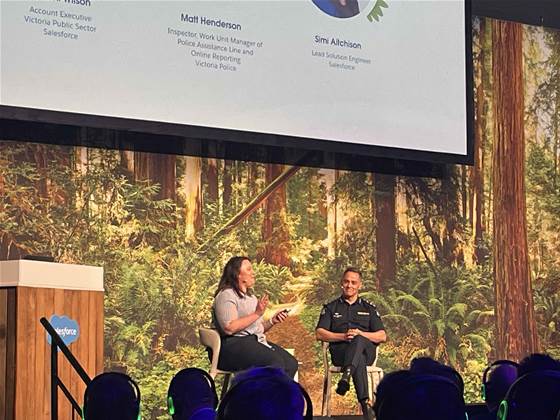Victoria Police has incorporated generative AI into a self-service non-urgent crime reporting tool to summarise information in a way that frontline officers are accustomed to receiving it.

The police assistance line (PAL) and online reporting (OLR) channels were set up in 2018, with the intention of removing about 800,000 non-urgent crime reporting and general inquiries a year from 000 Vic and police stations.
Around 150,000 crime reports are now taken through these channels, inspector Matt Henderson told an Agentforce summit in Melbourne late last month.
About 80 percent of reports are taken over the phone via an outsourced contact centre operated by Serco.
Agents in the contact centre are trained to take information from the public and put it into a short “narrative” format that frontline police are used to writing and consuming.
The remaining 20 percent of crime reports are self-reported via an online form powered by Salesforce OmniStudio.
The contents of the digital form are still handled by a human agent before the report is referred to frontline officers, but now the contact centre agent can apply generative AI to the contents to create the summary that officers expect to receive.
“The use of AI enables us to provide input about what police would like to see in a form, extract that information from the mandatory and non mandatory fields, and combine it into a ‘word picture’ that’s similar or very much at the standard that a police officer would expect to see as the end user,” Henderson said.
Henderson said that on the day the AI enhancement went live, a non-urgent crime report was received via the online forms concerning the alleged theft of copper cabling from an electricity facility.
“A tradie had really quickly snapped out that report, and I was amazed at the detail in it,” Henderson said.
“A few minutes later, I was able to see a contact centre operative push ‘generate the narrative’ and watch in real-time [it] write out the story the police were expecting to see.
“The staff on the ground were amazed at that, because even for a simple crime report where a bike’s been stolen, that would normally take them many minutes, so the saving we’ve seen here can’t be underestimated.
“We’re taking about 150,000 crime reports a year. If we’re saving three minutes on each one, we’ve saved about 8000 hours of labour a year with that one step.
“Not only that, we were able to give the community a good way of replicating a police narrative with no knowledge [of that process].”
The incorporation of AI was just one part of the refresh, which iTnews first reported in June.
Henderson said the original design of the online platform was “probably cutting-edge” in 2018, but was very much centred around what police wanted.
“There was legal jargon talking about the truth of the report you were going to make [and] the time it was going to take [to complete the form] - it just felt in 2025 like there were some barriers to encouraging people to stay in the experience,” Henderson said.
There was a considerable abandonment rate for the online forms, with only about 10 percent of visits resulting in a completed form.
“We were seeing about 30,000 visits to our online reporting page per month, but we were only translating those into about 3000 crime reports,” Henderson said.
“The abandon rate presented an opportunity … to figure out where people were falling out, and then [to] redesign it so that they stayed in the experience.”
DXC ran the project and revamp, working alongside Victoria Police and Serco.
“We’ve removed a lot of that legal nomenclature, we’ve added a progress bar so people can see how they’re travelling as they work through the forms, encouraging them to stay in, and then the actual look-and-feel and flow of the forms has got a great design,” Henderson said.
“The community was [also] constantly asking in our feedback forums about the ability to save and continue later, so they might commence a form, become distracted, and they would lose their progress and have to start all over again.”
This capability was also implemented as part of the uplift, as iTnews reported last month.
Aside from the dated user experience, one of the key reasons Victoria Police sought to upgrade the non-urgent crime reporting tool is that it hopes to push more volume through the online channel.
“What we now want to do is increase our business away from that primarily telephony-based [channel],” Henderson said.
“At the moment, we’re running at about 80 percent of our [non-urgent] crime reports coming from telephony and around 20 percent from online.
“We obviously want to promote, grow or direct the community to that self-serve [online] option so that we automate our processes better and [use] the existing footprint of staff that we have [to] take on other tasks.”
Further upgrades are planned for the online tool, including the potential addition of a conversational chatbot or software agent.
There are several use cases for this.
One is that the chatbot could support multiple languages, making it simpler for people to submit reports where there would otherwise be a language barrier.
A chatbot interface could also prevent abandoned reports by offering to connect the community member to a contact centre agent to assist in the moment.
“I think one of the next exciting projects that we’re talking about is the addition of a chatbot or ‘agent assist’ for a member of the public," Henderson explained.
"So when they’re navigating the forms, if they get stuck, there’s a pop-up assistant that helps them navigate, again encouraging them to stay in the system, or future scope they switch channels - they get stuck, they switch over to telephony-assisted, and maybe get through the bit that was troubling them, and [then move] back into the form is ideally what we’d like to see,”
An example of a chatbot was demonstrated on stage at the event.
Although it appears to be purely conceptual at this stage, Salesforce indicated some groundwork had been laid internally through an “AI ethics governance committee” and the data security division of digital services at Victoria Police.


.png&h=140&w=231&c=1&s=0)
_(20).jpg&h=140&w=231&c=1&s=0)






 iTnews Executive Retreat - Security Leaders Edition
iTnews Executive Retreat - Security Leaders Edition












_(1).jpg&h=140&w=231&c=1&s=0)



